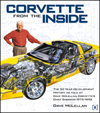|
Corvette From the Inside
Price: $49.95
|

Corvette Quarterly - Winter 2002
Launching the Powerful ZR-1
In the summer of 1988, word first leaked out through the press that the ZR-1 Corvette was about to be introduced. For once they were right, but how did they know? It wasn't until three months later that we in Corvette Engineering made the decision to build the first twenty production-level ZR-1s the following January. We planned to use fifteen of these cars for a ZR-1 press introduction and five for the final engine certification.
Press invitations and the other details (special activities, transportation, food, lodging, etc.) were the public relations (PR) department's responsibility. Needless to say, we all wanted to put the press in the best possible mood. If we expected the writers to write great stories about the car, we didn't want to feed them bad meals or put them up in fleabag hotels.
Because both Chevrolet and GM's NAVO (North American Vehicles Overseas) were to market the ZR-1, both PR teams met with us to plan press activities and to define our respective roles. In March 1989, Ralph Kramer, Chevrolet's Director of PR, planned to invite both the American and Canadian press to a major press evaluation for which he wanted all the ZR-1s he could get his hands on. Then Ray Koenig of NAVO PR threw us a curve: He also needed a ZR-1 in March for NAVO's display of US-built GM cars at the 59th Geneva International Auto Show, in Switzerland, and several weeks later he needed a few more for a European press evaluation.
The two events, staged simultaneously and 4,000 miles apart, would require more cars and personnel than we could muster. If we did not change our plans, the logistics of the ZR-1 introduction would be a nightmare. We needed to pinpoint the essentials of a successful ZR-1 introduction for Corvette Engineering and at the same time satisfy both Chevrolet and NAVO.
Designed as a road car, the ZR-1 needed great roads with an adjacent racetrack to fully show it off. Great roads are hilly, curvy, mountainous, and they give the driver a constant variety of challenging experiences. We also needed a racetrack if we wanted the writers, acting as test drivers, to safely and systematically explore the car's handling limits, and to be able to get the Corvette up to its impressive speeds.
As we sat there and racked our brains in the search for great roads and a contiguous road-racing track, Jim Ingle (Jingles), who was not only our development group trip captain but also a connoisseur of roads, whipped out his atlas. Together we reviewed all the roads of our past trips, but found that each one had its shortcomings. We looked at the great roads of the open range of the West. Nevada's long, flat roads were great for pure speed but had few turns to challenge the driver. Montana and Wyoming's spectacular roads were mile-high and subject to unpredictable snowstorms in March. What's more, the thin air at those altitudes would blunt the ZR-1's performance.
Every locale had its problems, and we hadn't even considered a road-racing track yet. Slowly, we realized that the combination of elements we needed for the press to test the ZR-1 (good weather, high speed limits, challenging roads, excellent road-racing track), could not be found in the United States in March.
Suddenly, Corvette Development Manager Doug Robinson remembered Goodyear's new test track?once a road-racing track?on the Mediterranean Sea, near Montpellier in Mireval, France. We realized that the answer to our site problem was Europe. What an audacious idea. We would give the press a ?no holds barred? European experience. The pieces of the puzzle finally began to fit together.
In the fall of 1988, four months before the ZR-1 introduction, Jean Phillipe Collow of GM France and Bob Lobell, European PR guru for Goodyear, joined Ed Lechtzin, Assistant Director of Public Relations for Chevrolet, and Doug Robinson in southern France to search for lodgings and roads.
Ed headed the group west, out of the Rhone Valley and past Mireval, for Toulouse. Halfway there, they spotted a castle perched dramatically on a hilltop. Investigating, they found La Cite, an eleventh-century walled fortress overlooking the modern city of Carcassonne and, inside, the Hotel du Donjon. With Ed intrigued at the prospect of having Le Cite and this hotel as the base of operations for the press, and the hotel manager interested in business in March when the hotel was normally closed, it was not long before a deal was struck. The manager agreed to have the hotel ready for us when we arrived the next spring.
On Tuesday March 7, 1989, the ZR-1 was introduced at the Geneva International Auto Show. Upstairs in the PALEXPO Exhibition Center, the Competition Yellow 1989 ZR-1 was poised with an unclad ZR-1 chassis. Spectators from all over the world jostled for position, while the press photographed the car and the chassis endlessly. Judging from the attention it was receiving, the ZR-1 was the hit of the show.
Having attended the Auto Show, the publishers then wanted to hit the road to do what they really came for?to test drive the ZR-1.
Most of this group was from the US, and they neither understood French nor were familiar with our Alpine route. As a consequence, we sent the cars off in small groups of four.
With drivers and passengers in place, we were off for Carcassonne. Down Geneva's narrow, twisting back streets, we slowly headed for the autoroute to the south where the pace picked up dramatically. The publishers, not surprisingly, observed the 80 mph speed limit for only a moment as they accelerated past traffic. In no time we reached the French border, where our twelve (four bright red, four dark red, and four dark blue) ZR-1s caused quite a stir. The gendarmes, baffled by what they saw, motioned us off to the side of the road. The publisher driving the lead car spoke in English. The gendarme listened in French. The publisher then showed the gendarme the packet of legal documents for the car. The ZR-1s were owned by a US company, manufactured in Kentucky, licensed in Michigan, and brought in under temporary permits through Germany to France. Finally, after much confusion, we were waved on our way.
The following day, the publishers were in Mireval, at Goodyear's proving ground, overlooking the Mediterranean from its hillside perch. Originally a road-racing track, Goodyear bought it and rebuilt it to do controlled tire-testing. Goodyear had just finished the inner track, which could be watered to a controlled depth for tire-testing. Publishers and press could evaluate the ZR-1 on the outer track at speeds almost comparable to what they had driven on the road. And, on the wetted inner track they could explore the directional Goodyear tires, with their wet handling capabilities, and the ABS brake system, with its controlled stopping.
In between track driving sessions, Jingles entertained the press with ZR-1 hole shots and his smoke trick, earning him the nickname ?Mr. Smoke.? Jim would take the next ZR-1 in line for a run on the track and stage it in front of the press. Revving the engine against the rev limiter at 7,200 rpm, he would let out the clutch and quickly get on the brakes. With the rear tires already spinning, the front brakes would hold the car stationary. Within seconds the car?with its engine screaming and the rear tires spinning?would be completely enveloped in smoke, presenting a rare photo opportunity for the Europeans. As childish as this might have seemed, it taught the Europeans in one lesson what we couldn't convince them of in words: This was one tough car!
It was a letdown to have to pack up and go home after such a memorable exploration of a car that we had all labored so hard to produce. Now, we had to wait for the press reports in the magazines and the hoped-for feeding frenzy when the ZR-1 hit the Chevrolet dealer showrooms.
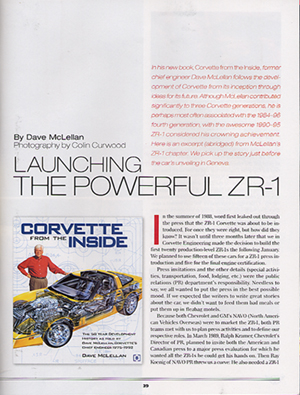
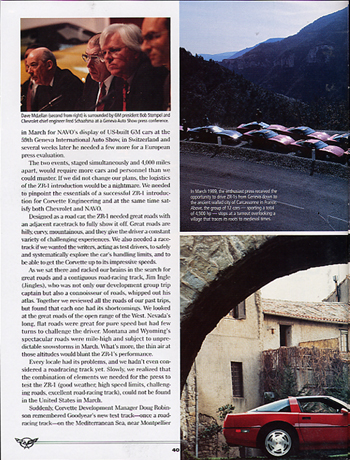
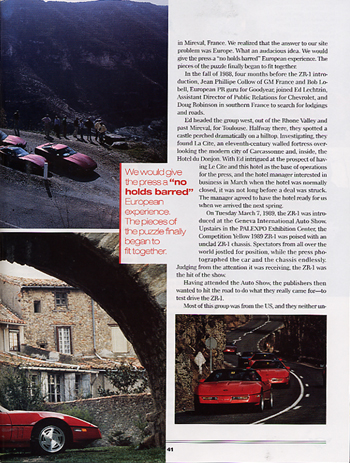
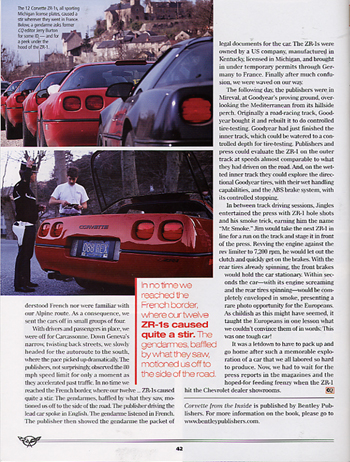
![[B] Bentley Publishers](http://assets1.bentleypublishers.com/images/bentley-logos/bp-banner-234x60-bookblue.jpg)
